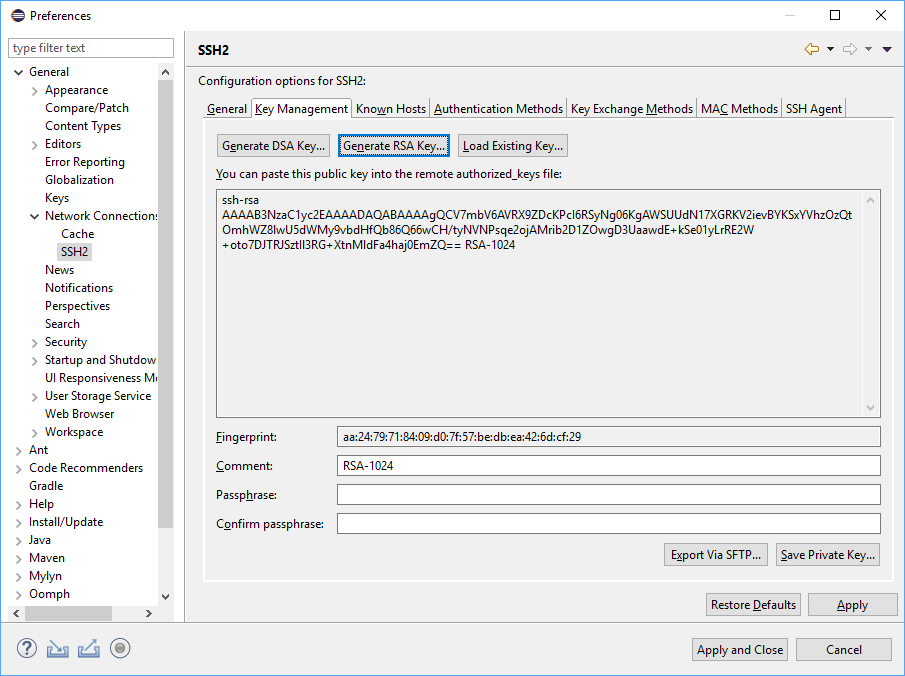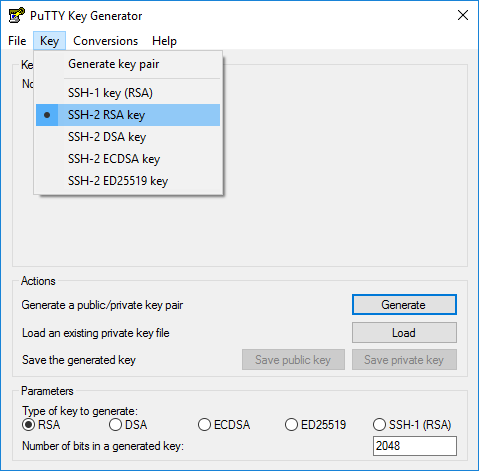Generating Custom Ssh Key Mac
- Ssh Key Generation Linux
- Mac Os Generate Ssh Key
- Mac Ssh Key Location
- Generating Custom Ssh Key Mac Pro
- Ssh Key Github
Aug 12, 2010 This document describes the procedure of generating an SSH key using the Terminal application and then submitting the key to WiscList Custom. Completing WiscList Custom Setup When your request for a Custom WiscList is approved, you will be sent an email notification containing a link to complete the setup procedure. The following command creates an SSH key pair using RSA encryption and a bit length of 4096: ssh-keygen -m PEM -t rsa -b 4096 If you use the Azure CLI to create your VM with the az vm create command, you can optionally generate SSH public and private key files using the -generate-ssh-keys option.
3 days ago I’ve been fortunate until recently that my personal SSH key was acceptable. So, how can you have two or more SSH keys available on your system at any one time? I am running a Mac but I assume this would work on Linux as well. It’s not hard and when setup, it works really well. Getting Started. The first part is generate a new SSH key. Generating A Key Pair. Generating a key pair is easy with SSH. On a Mac OS X or Linux system, Andrea just has to use the 'ssh-keygen' command. Generating & Adding SSH Keys to a Server. Jan 24, 2017 This video describes the workflow for generating RSA Key Pairs on a Mac device using JumpCloud. The process can be replicated on a Linux device. Not included in the video is a demonstration of RSA. Mar 22, 2019 To generate a new Key pair, run the following commands on your home computer. Open your terminal and run the following command under your username. local$ ssh-keygen -t rsa This creates a public/private keypair of the type (-t) rsa.
Ssh Key Generation Linux
SSH keys are one of the most secure ways to access a web server, since it requires authentication beyond a simple password. While each new Packet server has a root password assigned, it is removed from the customer portal after 24 hours - after which point you’ll need to leverage SSH or need to have added a new root password to the machine.
Generating SSH Keys
The Mac/Linux WayThis is pretty simple. The first step is to create a key pair on your local machine or your work station. Open a Command line and type:
ssh-keygen -t rsa
Once you have entered the ssh-keygen command, you will go through with these questions.
Enter file in which to save the key (/home/name/.ssh/id_rsa):
You can use the default name and destination if this is your first ssh key.
Enter passphrase (empty for no passphrase):
Usually, System Administrators/DevOps do not use passphrase on their keys -- well admit it, one reason we use ssh key is to gain a secure, passwordless login to the server, right?
But if you feel the need of extra layer security, you may go ahead and type in your passphrase.
Once you are done, the key file ending in '.pub' contains the key that you need to upload to Packet Portal. It should go without saying, but we'll say it anyway, do not share your private key (located here /home/yourname/.ssh/<key-name>) with anyone!
bandizip for mac free download Your public SSH key is commonly located here /home/yourname/.ssh/<key-name>.pub and you can display your public SSH key with the following command:
cat ~/.ssh/id_rsa.pub
The PuTTY Way (Windows)
First, Download PuTTY. The two binaries you will need are:
- PuTTY (the SSH and Telnet client itself)
- PuTTYgen (an RSA and DSA key generation utility)
Next, open PuTTYgen.exe which will look like this:
You can change the parameters for your key, even though the default ones are just fine. Any software serial key generator free download. When you’re ready, click Generate.
In order to create a random key, you will be asked to move the cursor around a small empty area on the window. This randomness is called entropy and is used to create keys in a secure way that cannot be reproduced by others.
After a few seconds, once the keys are ready, you will be presented with this view:
Click the Save private key button, name it whatever you like and choose a secure location to save the key with the extension '.ppk'.
Repeat the same thing after clicking on Save public key. This time, make sure to give it an extension like '.txt', so you can open it later in a regular text editor.

Note! If you open the public key text file you just saved, you will probably see that it contains something that looks like the following:
Why Putty saves it in this format is unclear, but it is not an accepted form of adding the public key.
So, for that reason, you might want to copy whatever the Putty Generator shows on the Public key window and paste it on the document, after deleting everything that was there before.
It should look like: ssh-rsa AAAA... rsa-key-xxxxxxx
Adding Your Key to the Packet Portal
Mac Os Generate Ssh Key
Once you have generated an SSH key pair you can upload the public key to your account. Via the packet portal, go to 'SSH Keys' on the left-hand side and click 'Add SSH Key' In the lower right-hand corner.
Understanding SSH at Packet: Personal Keys vs Project Keys
When adding a key in the Packet Portal, you can choose to add either Project Key or a Personal Key.
As you can see, a Personal Key will be included on all new machines in the projects that you own, or of which you are a collaborator. Ms office 13 key generator.
You can also choose to create and manage a key that is specific to a single project (which will be included by default on servers deployed into a particular project). This 2nd option is useful if you don’t want to use a personal key that you leverage in lots of places on a shared box.
Getting Your Key(s) on Your Server(s)
Mac Ssh Key Location
We use our cloud-init service to add all the selected keys (Personal + Project specific + Collaborator) onto each machine at provision time. So as soon as your box is deployed, you can access it via SSH. Nice!
This also means that any keys you (or your collaborators) add via the Packet portal after a server is provisioned won’t be available on the machine automatically. You’ll have to add new keys. Here are a couple of different situations:
Adding New SSH Keys to An Existing Server
Add Your New SSH Key to the Portal:
- Navigate to the SSH Keys section of the Packet portal.
- Add your public SSH key. Note that below the key value area, you will see an option to associate this new key with a specific server. You may also select “all of them” if you have many existing servers. Be sure to select the servers that need this new SSH key!

Now that you that the key is added in portal, you need to force add it to your server(s).
Use our SOS service to login with (root + pw) and manually add the new key on the authorized_keys file.
Logging In Via SSH
Mac/LinuxSSH access on Mac and Linux is straightforward. Simply run the command:
ssh [email protected]<your_Public IPv4>
WindowsRun the PuTTY.exe binary downloaded earlier go to 'Data' under 'Connection', and add root in the field of the username.
Go to Authentication, under SSH, and click the Browse button, to add the private SSH key created earlier.
Now go to Session, enter the public IP address of your server, give a name to the session, and click Open.
Generating Custom Ssh Key Mac Pro
Et voila, you now have SSH access to your server and can continue on with your day.
Ssh Key Github
Was it helpful?